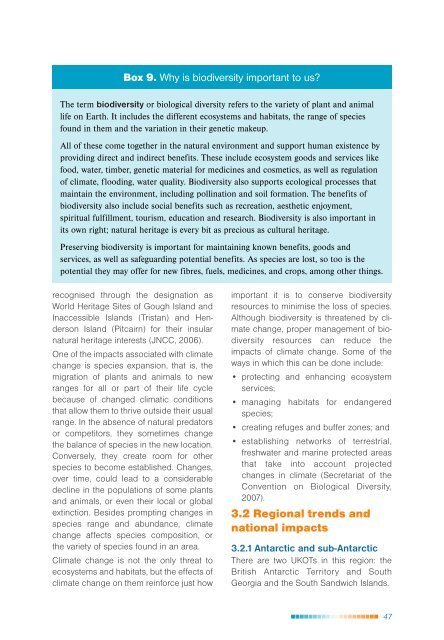Climate change in the UKOTs an overview of the ... - JNCC - Defra
Climate change in the UKOTs an overview of the ... - JNCC - Defra
Climate change in the UKOTs an overview of the ... - JNCC - Defra
Create successful ePaper yourself
Turn your PDF publications into a flip-book with our unique Google optimized e-Paper software.
Box 9. Why is biodiversity import<strong>an</strong>t to us?<br />
The term biodiversity or biological diversity refers to <strong>the</strong> variety <strong>of</strong> pl<strong>an</strong>t <strong>an</strong>d <strong>an</strong>imal<br />
life on Earth. It <strong>in</strong>cludes <strong>the</strong> different ecosystems <strong>an</strong>d habitats, <strong>the</strong> r<strong>an</strong>ge <strong>of</strong> species<br />
found <strong>in</strong> <strong>the</strong>m <strong>an</strong>d <strong>the</strong> variation <strong>in</strong> <strong>the</strong>ir genetic makeup.<br />
All <strong>of</strong> <strong>the</strong>se come toge<strong>the</strong>r <strong>in</strong> <strong>the</strong> natural environment <strong>an</strong>d support hum<strong>an</strong> existence by<br />
provid<strong>in</strong>g direct <strong>an</strong>d <strong>in</strong>direct benefits. These <strong>in</strong>clude ecosystem goods <strong>an</strong>d services like<br />
food, water, timber, genetic material for medic<strong>in</strong>es <strong>an</strong>d cosmetics, as well as regulation<br />
<strong>of</strong> climate, flood<strong>in</strong>g, water quality. Biodiversity also supports ecological processes that<br />
ma<strong>in</strong>ta<strong>in</strong> <strong>the</strong> environment, <strong>in</strong>clud<strong>in</strong>g poll<strong>in</strong>ation <strong>an</strong>d soil formation. The benefits <strong>of</strong><br />
biodiversity also <strong>in</strong>clude social benefits such as recreation, aes<strong>the</strong>tic enjoyment,<br />
spiritual fulfillment, tourism, education <strong>an</strong>d research. Biodiversity is also import<strong>an</strong>t <strong>in</strong><br />
its own right; natural heritage is every bit as precious as cultural heritage.<br />
Preserv<strong>in</strong>g biodiversity is import<strong>an</strong>t for ma<strong>in</strong>ta<strong>in</strong><strong>in</strong>g known benefits, goods <strong>an</strong>d<br />
services, as well as safeguard<strong>in</strong>g potential benefits. As species are lost, so too is <strong>the</strong><br />
potential <strong>the</strong>y may <strong>of</strong>fer for new fibres, fuels, medic<strong>in</strong>es, <strong>an</strong>d crops, among o<strong>the</strong>r th<strong>in</strong>gs.<br />
recognised through <strong>the</strong> designation as<br />
World Heritage Sites <strong>of</strong> Gough Isl<strong>an</strong>d <strong>an</strong>d<br />
Inaccessible Isl<strong>an</strong>ds (Trist<strong>an</strong>) <strong>an</strong>d Henderson<br />
Isl<strong>an</strong>d (Pitcairn) for <strong>the</strong>ir <strong>in</strong>sular<br />
natural heritage <strong>in</strong>terests (<strong>JNCC</strong>, 2006).<br />
One <strong>of</strong> <strong>the</strong> impacts associated with climate<br />
<strong>ch<strong>an</strong>ge</strong> is species exp<strong>an</strong>sion, that is, <strong>the</strong><br />
migration <strong>of</strong> pl<strong>an</strong>ts <strong>an</strong>d <strong>an</strong>imals to new<br />
r<strong>an</strong>ges for all or part <strong>of</strong> <strong>the</strong>ir life cycle<br />
because <strong>of</strong> <strong>ch<strong>an</strong>ge</strong>d climatic conditions<br />
that allow <strong>the</strong>m to thrive outside <strong>the</strong>ir usual<br />
r<strong>an</strong>ge. In <strong>the</strong> absence <strong>of</strong> natural predators<br />
or competitors, <strong>the</strong>y sometimes <strong>ch<strong>an</strong>ge</strong><br />
<strong>the</strong> bal<strong>an</strong>ce <strong>of</strong> species <strong>in</strong> <strong>the</strong> new location.<br />
Conversely, <strong>the</strong>y create room for o<strong>the</strong>r<br />
species to become established. Ch<strong>an</strong>ges,<br />
over time, could lead to a considerable<br />
decl<strong>in</strong>e <strong>in</strong> <strong>the</strong> populations <strong>of</strong> some pl<strong>an</strong>ts<br />
<strong>an</strong>d <strong>an</strong>imals, or even <strong>the</strong>ir local or global<br />
ext<strong>in</strong>ction. Besides prompt<strong>in</strong>g <strong>ch<strong>an</strong>ge</strong>s <strong>in</strong><br />
species r<strong>an</strong>ge <strong>an</strong>d abund<strong>an</strong>ce, climate<br />
<strong>ch<strong>an</strong>ge</strong> affects species composition, or<br />
<strong>the</strong> variety <strong>of</strong> species found <strong>in</strong> <strong>an</strong> area.<br />
<strong>Climate</strong> <strong>ch<strong>an</strong>ge</strong> is not <strong>the</strong> only threat to<br />
ecosystems <strong>an</strong>d habitats, but <strong>the</strong> effects <strong>of</strong><br />
climate <strong>ch<strong>an</strong>ge</strong> on <strong>the</strong>m re<strong>in</strong>force just how<br />
import<strong>an</strong>t it is to conserve biodiversity<br />
resources to m<strong>in</strong>imise <strong>the</strong> loss <strong>of</strong> species.<br />
Although biodiversity is threatened by climate<br />
<strong>ch<strong>an</strong>ge</strong>, proper m<strong>an</strong>agement <strong>of</strong> biodiversity<br />
resources c<strong>an</strong> reduce <strong>the</strong><br />
impacts <strong>of</strong> climate <strong>ch<strong>an</strong>ge</strong>. Some <strong>of</strong> <strong>the</strong><br />
ways <strong>in</strong> which this c<strong>an</strong> be done <strong>in</strong>clude:<br />
• protect<strong>in</strong>g <strong>an</strong>d enh<strong>an</strong>c<strong>in</strong>g ecosystem<br />
services;<br />
• m<strong>an</strong>ag<strong>in</strong>g habitats for end<strong>an</strong>gered<br />
species;<br />
• creat<strong>in</strong>g refuges <strong>an</strong>d buffer zones; <strong>an</strong>d<br />
• establish<strong>in</strong>g networks <strong>of</strong> terrestrial,<br />
freshwater <strong>an</strong>d mar<strong>in</strong>e protected areas<br />
that take <strong>in</strong>to account projected<br />
<strong>ch<strong>an</strong>ge</strong>s <strong>in</strong> climate (Secretariat <strong>of</strong> <strong>the</strong><br />
Convention on Biological Diversity,<br />
2007).<br />
3.2 Regional trends <strong>an</strong>d<br />
national impacts<br />
3.2.1 Antarctic <strong>an</strong>d sub-Antarctic<br />
There are two <strong>UKOTs</strong> <strong>in</strong> this region: <strong>the</strong><br />
British Antarctic Territory <strong>an</strong>d South<br />
Georgia <strong>an</strong>d <strong>the</strong> South S<strong>an</strong>dwich Isl<strong>an</strong>ds.<br />
47

















